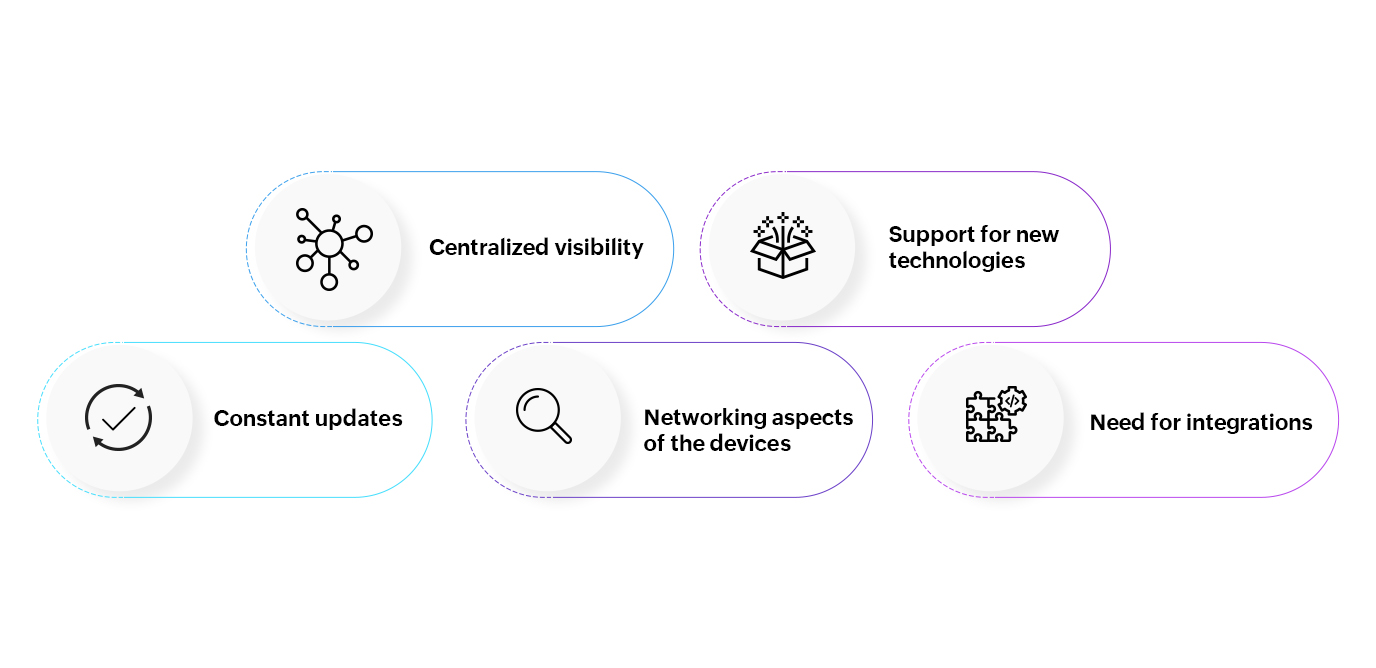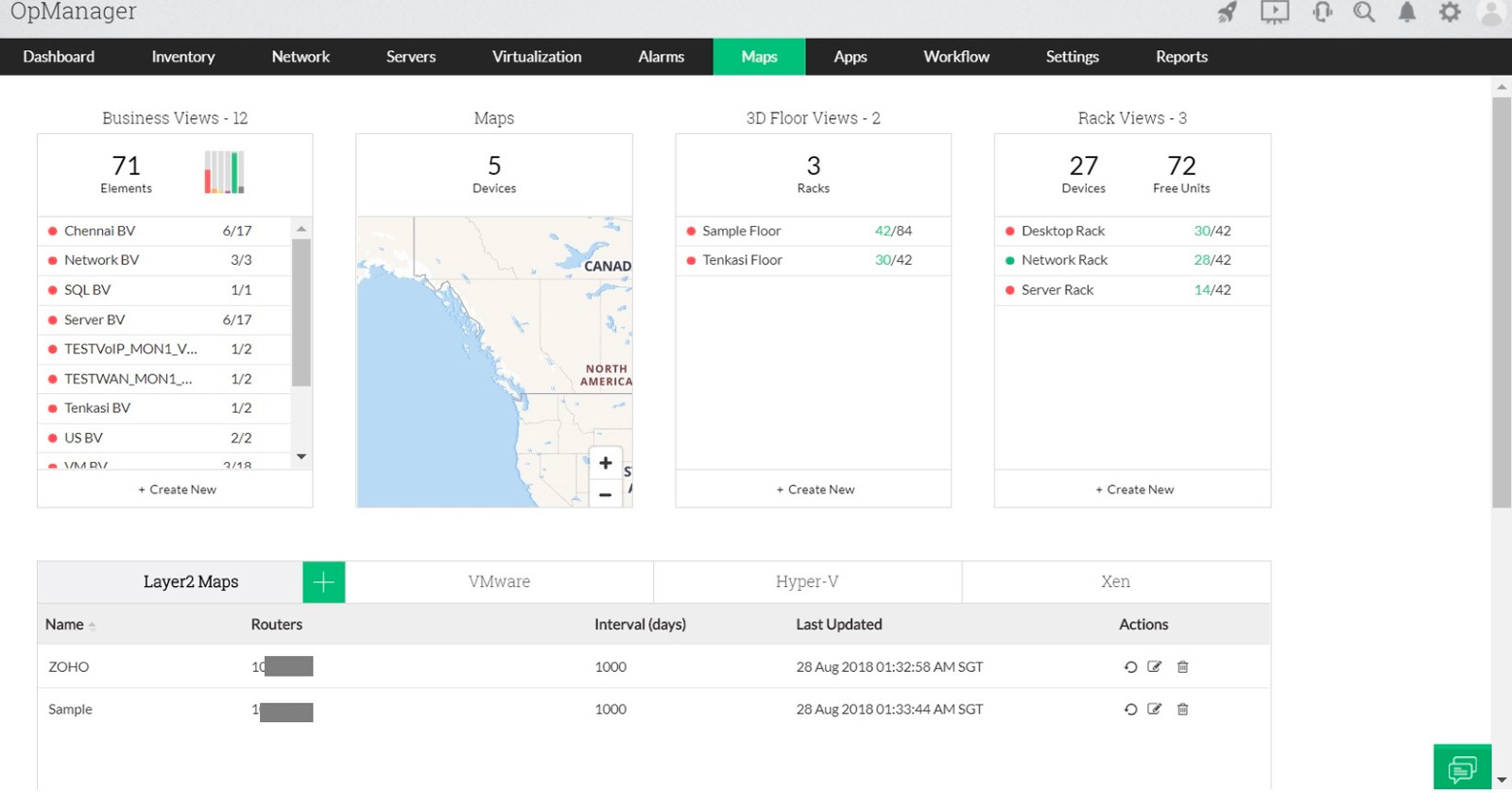Network mapping has helped IT admins gain greater control and visibility over their networks by dividing complex networks into smaller, manageable chunks. It helps in visualizing how different network components such as servers, switch ports, and routers interconnect to carry out their functions. By representing how network devices communicate, network maps offer actionable insights for managing, scaling, and troubleshooting networks. This has also helped IT admins easily run audits, check performance, and ensure the security of mapped network devices.
With that being said, creating and maintaining network maps isn't as easy as it sounds. It requires manual legwork, active network probing, and continual status updates. Network admins depend on a number of network protocols, CLI commands, and point tools to generate network maps. This has created some hurdles to effective network topology mapping and monitoring.

Now, let's do a deep dive into each of the above challenges.
Network mapping isn't just setting up maps once and referring back to them whenever needed. Since most networks are dynamic in nature, your network map should also evolve along with your network. Only up-to-date network maps serve their purpose, such as aiding in remote troubleshooting, whereas outdated network maps can be misleading and might not contain sufficient information about mapped devices.
For instance, say that one of your critical devices is facing a networking issue. Using a network map, you identify that this device is connected to a faulty switch port. To ensure the other devices connected to the switch port are not affected, and to connect them to a better switch port, you need to quickly identify all the connected devices. While tracing cables manually can help, it's impractical in scenarios such as remote troubleshooting. This is where network maps boost your troubleshooting ability. However, if your map isn't up to date, then you might miss out on newly added devices while trying to identify and fix devices that have been removed from the network. To avoid this hassle, you have to constantly add, delete, or update mapped devices as your network changes, requiring a substantial amount of manual work and time.
It's impractical to encompass all the networking components and their attributes into one network map. Network admins rely on different network maps that are created as needed.
For instance:
These different maps can be created using different approaches such as manual mapping, semi-automated mapping, and fully automated mapping. For example, creating custom network maps of distinct geographies such as business view maps can be done manually. However, manual mapping isn't used to map complex IT environments.
Network admins rely on all different types of maps and mapping techniques to achieve full coverage of their network. This is tedious and ineffective because they have to switch between different tools and solutions to create, view, and manipulate these maps.
It's not sufficient for network maps to only contain network components and their interconnections. They should also be able to give insights into the networking attributes of the mapped components. For instance, a Layer 2 map should display the IP address, the MAC address, and the status of a mapped device. This helps admins more easily understand the mapped network and enables effective network management.
Nevertheless, most traditional network mapping tools offer surface-level insights or no insights into the mapped components. Network admins are required to correlate data from other monitoring tools to check the networking attributes of the required devices. This causes data collection overhead and is time-consuming.
With networks rapidly adopting newer technologies and networking concepts, traditional network mapping techniques and tools don't make the cut anymore. Even with the use of efficient network mapping software, network admins should ensure that their tools are constantly updated and patched to support new technologies and eliminate the threats of new network vulnerabilities.
For instance, with the advent of cloud technologies and network containerization, network admins should now be able to map physical, virtual, hybrid, and cloud network components.
One of the primary uses of network maps is their ability to speed up the troubleshooting process. Effective network maps can aid network admins in several stages of network troubleshooting, including identifying the root cause of a network issue, tracking down the components causing an issue, identifying the connected device, and isolating the affected network region.
The challenge arises when network admins need to collect information and collaborate with their team to resolve the network issue. Often this requires using different tools for network probing, scanning, data collection, task assignment, and team collaboration.
OpManager behaves as an effective network monitor and its network mapping solution enables in-depth visibility into mapped network components. Its all-in-one approach to network performance monitoring can help you avoid the disparity of using different tools for mapping and monitoring the performance of mapped components.
Built as a comprehensive network monitoring solution, OpManager offers various mapping options including Business Views, 3D Floor Views, Rack Views, and Layer 2 Maps. With its powerful network performance monitor, you can inspect a mapped device's networking aspects, set up threshold-based alerts, and monitor on the go with the integrated mobile app. Not only that, OpManager tightly integrates with your other network management solutions, including NetFlow Analyzer, to monitor networking aspects such as the bandwidth consumed by your mapped devices. You can choose to integrate your team's communication channels, such as Slack, to enable seamless task assignment and tracking.

Looking for a reliable network mapping solution? Try OpManager today! Schedule a personalized live demo of the solution with our product experts, or download a free, 30-day trial!